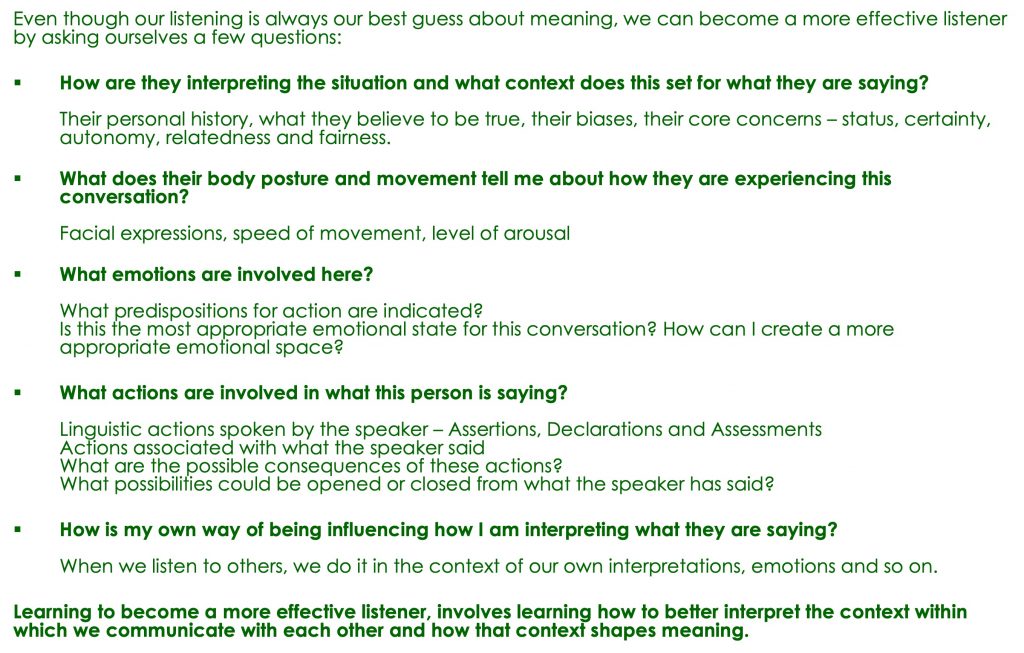
What does it take to be a good listener? I have touched on what we can listen for such as the various linguistic actions and others’ concerns. However, we can also look at how we can engage in others in conversations.
Openness
Openness speaks to an acceptance of others’ ways of being and worldview and to see them as ‘legitimate others’. Without such acceptance, our listening will always be constrained to our own worldview as context. We may leap to conclusions about the way things should be and, in that moment, fail to develop our understanding what the other is saying.
Curiosity
Building on openness, curiosity invites the exploration of ideas. It opens up the space of possibilities for both listener and speaker allowing both to move beyond the obvious. Curiosity demands questions and, preferably open questions, to expand and understand what another might mean in their speaking and what concerns are being addressed.
Attention
We are always listening but not necessarily to the person who is speaking to us. To be an effective listener, it might seem obvious but we must attend to the person speaking. When we do so, we further engage them in the conversation and build up a rapport promoting the possibility of deeper conversations.
Clarity
We can seek clarity in any conversation by:
- Attentively listening to the other’s story;
- Reflecting back our interpretation of what we hear;
- Empathically checking with others about their emotional state and its meaning;
- Asking questions to obtain clarity or take the conversation to a different level if that seems appropriate; and
- Checking the listening of others to ensure that our speaking has been clear for them.
Context
Developing a more shared context is critical to effective listening. Too easily we can assume we know the context in which the other person is speaking. Although we can never actually know their contextual frame work, we can make good guesses. To explore the context more deeply, we can consider the following:
- The historical and cultural narratives of those involved in the conversation;
- Our prejudices and preferences, stories about ourselves and the others involved and our concerns and predispositions;
- The emotional and physical space in which the conversation is taking place;
- The spoken words framing the actions embedded in what is said.
Intuition
Intuition can be seen as a hunch, an answer or perspective that just shows up in our automatic listening – our predictive brain processes. We are creating meaning outside our immediate awareness, yet this can often provide a way of taking care of our concerns in life.
In summary, we can improve our engagement in conversations by addressing the following:
- How are they interpreting the situation and what context does this set for what they are saying?
Their personal history, what they believe to be true, their biases, their core concerns – status, certainty, autonomy, relatedness and fairness.
- What does their body posture and movement tell us about how they are experiencing this conversation?
Facial expressions, speed of movement, level of arousal
- What emotions are involved here?
What predispositions for action are indicated?
Is this the most appropriate emotional state for this conversation? How can we create a more appropriate emotional space?
- What actions are involved in what this person is saying?
Linguistic actions spoken by the speaker – Assertions, Declarations and Assessments
Actions associated with what the speaker said
What are the possible consequences of these actions?
What possibilities could be opened or closed from what the speaker has said?
- How is our own way of being influencing how we are interpreting what they are saying?
When we listen to others, we do it in the context of our own interpretations, emotions and so on
